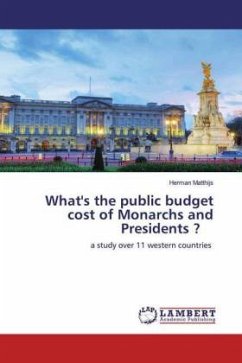Greg G. Chen, Lynne A. Weikart, Daniel W. Williams
Budget Tools
Financial Methods in the Public Sector
Greg G. Chen, Lynne A. Weikart, Daniel W. Williams
Budget Tools
Financial Methods in the Public Sector
- Broschiertes Buch
- Merkliste
- Auf die Merkliste
- Bewerten Bewerten
- Teilen
- Produkt teilen
- Produkterinnerung
- Produkterinnerung
Using budgets from all levels of government, as well as from non-profit organizations, this text brings together scores of exercises that will take students through the process of public budgeting, from organizing data, all the way through to analysis and presentation.
Andere Kunden interessierten sich auch für
![The 12-Bottle Bar The 12-Bottle Bar]() David SolmonsonThe 12-Bottle Bar11,99 €
David SolmonsonThe 12-Bottle Bar11,99 €![How We Give Now How We Give Now]() Lucy BernholzHow We Give Now34,99 €
Lucy BernholzHow We Give Now34,99 €![What's the public budget cost of Monarchs and Presidents ? What's the public budget cost of Monarchs and Presidents ?]() Herman MatthijsWhat's the public budget cost of Monarchs and Presidents ?18,99 €
Herman MatthijsWhat's the public budget cost of Monarchs and Presidents ?18,99 €![The Public Administration Workbook The Public Administration Workbook]() Dennis Dresang (University of Wisconsin, Madison, USA)The Public Administration Workbook175,99 €
Dennis Dresang (University of Wisconsin, Madison, USA)The Public Administration Workbook175,99 €![Effective Writing in the Public Sector Effective Writing in the Public Sector]() John W. Swain (Governors State University, University Park, IllinoiEffective Writing in the Public Sector53,99 €
John W. Swain (Governors State University, University Park, IllinoiEffective Writing in the Public Sector53,99 €![How We Give Now How We Give Now]() Lucy BernholzHow We Give Now27,99 €
Lucy BernholzHow We Give Now27,99 €![Tools for Teaching Conceptual Understanding, Elementary Tools for Teaching Conceptual Understanding, Elementary]() Julie SternTools for Teaching Conceptual Understanding, Elementary48,99 €
Julie SternTools for Teaching Conceptual Understanding, Elementary48,99 €-
-
-
Using budgets from all levels of government, as well as from non-profit organizations, this text brings together scores of exercises that will take students through the process of public budgeting, from organizing data, all the way through to analysis and presentation.
Hinweis: Dieser Artikel kann nur an eine deutsche Lieferadresse ausgeliefert werden.
Hinweis: Dieser Artikel kann nur an eine deutsche Lieferadresse ausgeliefert werden.
Produktdetails
- Produktdetails
- Verlag: SAGE Publications Inc
- 2 Revised edition
- Seitenzahl: 384
- Erscheinungstermin: 19. November 2014
- Englisch
- Abmessung: 235mm x 191mm x 21mm
- Gewicht: 726g
- ISBN-13: 9781483307701
- ISBN-10: 1483307700
- Artikelnr.: 39408825
- Herstellerkennzeichnung
- Libri GmbH
- Europaallee 1
- 36244 Bad Hersfeld
- gpsr@libri.de
- Verlag: SAGE Publications Inc
- 2 Revised edition
- Seitenzahl: 384
- Erscheinungstermin: 19. November 2014
- Englisch
- Abmessung: 235mm x 191mm x 21mm
- Gewicht: 726g
- ISBN-13: 9781483307701
- ISBN-10: 1483307700
- Artikelnr.: 39408825
- Herstellerkennzeichnung
- Libri GmbH
- Europaallee 1
- 36244 Bad Hersfeld
- gpsr@libri.de
Greg G. Chen is associate professor at Baruch College School of Public Affairs, City University of New York. He was a manager of the budgeting and financial reporting department in the Ministry of Finance, and budget manager and senior policy adviser for the Premier's Office of British Columbia, Canada, before taking his professorship in the United States. He had previously been an associate dean in the College of WISCO in China. Professor Chen conducts research and publishes papers in the areas of budgeting and financial management for nonprofit organizations and governments, program evaluation and cost-benefit analysis of diverse public programs, and comparisons of the health care systems and finance in Canada, the United States, and China.
Part 1: Introduction
Module 1: The Craft of Budgeting
Part 2: Budget Tools
Module 2: Organizing Budget Data
Module 3: Fixed and Variable Costs
Module 4: Breakeven Analysis
Module 5: Cost Allocation
Module 6: Time Value of Money
Module 7: Inflation
Module 8: Sensitivity Analysis
Module 9: Integrating Budgeting With Performance
Part 3: The Budget Process
Module 10: The Budget Process: An Overview
Module 11: The Budget Document
Module 12: Determining the Baseline Budget
Module 13: Decision Packages: Cost Estimates
Module 14: Decision Packages: Budget Justifications
Module 15: Budget Cutbacks
Module 16: Legislative Budget Tools
Part 4: Capital Budgeting and Asset Management
Module 17: Cost-Benefit Analysis
Module 18: Life Cycle Costing
Module 19: Capitalization and Depreciation
Module 20: Long-Term Financing
Module 21: Investment Strategies
Part 5: Budget Implementation
Module 22: Operating Plan and Variance Analysis
Module 23: Cash Management and Internal Controls
Module 24: Forecasting and Managing Cash Flow
Module 25: Government and Nonprofit Accounting
Module 26: Financial Statement Analysis
Part 6: Advanced Tools
Module 27: Calculating Payroll
Module 28: Basic Forecasting Concepts
Module 29: Forecasting Intermediate Forecasting
Module 30: Forecasting Advanced Intermediate Methods
Module 1: The Craft of Budgeting
Part 2: Budget Tools
Module 2: Organizing Budget Data
Module 3: Fixed and Variable Costs
Module 4: Breakeven Analysis
Module 5: Cost Allocation
Module 6: Time Value of Money
Module 7: Inflation
Module 8: Sensitivity Analysis
Module 9: Integrating Budgeting With Performance
Part 3: The Budget Process
Module 10: The Budget Process: An Overview
Module 11: The Budget Document
Module 12: Determining the Baseline Budget
Module 13: Decision Packages: Cost Estimates
Module 14: Decision Packages: Budget Justifications
Module 15: Budget Cutbacks
Module 16: Legislative Budget Tools
Part 4: Capital Budgeting and Asset Management
Module 17: Cost-Benefit Analysis
Module 18: Life Cycle Costing
Module 19: Capitalization and Depreciation
Module 20: Long-Term Financing
Module 21: Investment Strategies
Part 5: Budget Implementation
Module 22: Operating Plan and Variance Analysis
Module 23: Cash Management and Internal Controls
Module 24: Forecasting and Managing Cash Flow
Module 25: Government and Nonprofit Accounting
Module 26: Financial Statement Analysis
Part 6: Advanced Tools
Module 27: Calculating Payroll
Module 28: Basic Forecasting Concepts
Module 29: Forecasting Intermediate Forecasting
Module 30: Forecasting Advanced Intermediate Methods
Part 1: Introduction
Module 1: The Craft of Budgeting
Part 2: Budget Tools
Module 2: Organizing Budget Data
Module 3: Fixed and Variable Costs
Module 4: Breakeven Analysis
Module 5: Cost Allocation
Module 6: Time Value of Money
Module 7: Inflation
Module 8: Sensitivity Analysis
Module 9: Integrating Budgeting With Performance
Part 3: The Budget Process
Module 10: The Budget Process: An Overview
Module 11: The Budget Document
Module 12: Determining the Baseline Budget
Module 13: Decision Packages: Cost Estimates
Module 14: Decision Packages: Budget Justifications
Module 15: Budget Cutbacks
Module 16: Legislative Budget Tools
Part 4: Capital Budgeting and Asset Management
Module 17: Cost-Benefit Analysis
Module 18: Life Cycle Costing
Module 19: Capitalization and Depreciation
Module 20: Long-Term Financing
Module 21: Investment Strategies
Part 5: Budget Implementation
Module 22: Operating Plan and Variance Analysis
Module 23: Cash Management and Internal Controls
Module 24: Forecasting and Managing Cash Flow
Module 25: Government and Nonprofit Accounting
Module 26: Financial Statement Analysis
Part 6: Advanced Tools
Module 27: Calculating Payroll
Module 28: Basic Forecasting Concepts
Module 29: Forecasting Intermediate Forecasting
Module 30: Forecasting Advanced Intermediate Methods
Module 1: The Craft of Budgeting
Part 2: Budget Tools
Module 2: Organizing Budget Data
Module 3: Fixed and Variable Costs
Module 4: Breakeven Analysis
Module 5: Cost Allocation
Module 6: Time Value of Money
Module 7: Inflation
Module 8: Sensitivity Analysis
Module 9: Integrating Budgeting With Performance
Part 3: The Budget Process
Module 10: The Budget Process: An Overview
Module 11: The Budget Document
Module 12: Determining the Baseline Budget
Module 13: Decision Packages: Cost Estimates
Module 14: Decision Packages: Budget Justifications
Module 15: Budget Cutbacks
Module 16: Legislative Budget Tools
Part 4: Capital Budgeting and Asset Management
Module 17: Cost-Benefit Analysis
Module 18: Life Cycle Costing
Module 19: Capitalization and Depreciation
Module 20: Long-Term Financing
Module 21: Investment Strategies
Part 5: Budget Implementation
Module 22: Operating Plan and Variance Analysis
Module 23: Cash Management and Internal Controls
Module 24: Forecasting and Managing Cash Flow
Module 25: Government and Nonprofit Accounting
Module 26: Financial Statement Analysis
Part 6: Advanced Tools
Module 27: Calculating Payroll
Module 28: Basic Forecasting Concepts
Module 29: Forecasting Intermediate Forecasting
Module 30: Forecasting Advanced Intermediate Methods









